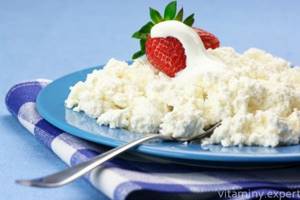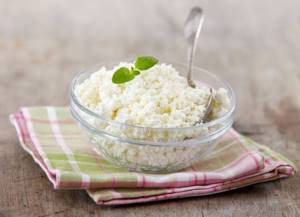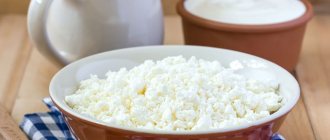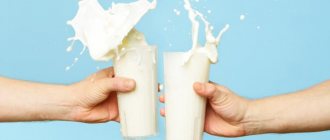Everyone knows that cottage cheese is not only a tasty product, but also very healthy. It contains a lot of useful components, and scientists and doctors around the world have been talking about its benefits for many centuries. We can talk endlessly about its benefits.
Every person should eat this fermented milk product almost daily. It is introduced into the diet of children starting from 6 months and we use it for the rest of our lives. Therefore, it is worth getting to know this useful product as closely as possible and examining it from all sides, so to speak.
How and from what is cottage cheese made?
Cottage cheese is a completely natural product, of course, provided it is prepared in the classic way from the right product. It is prepared from whole or skim milk, depending on the required fat content of the final product.
[YaDir03]
Initially, milk is acidified, during this process natural lactic acid bacteria are formed in the milk. This sour milk is then heated, and as the temperature rises, the milk begins to curdle.
Then it is thrown, for example, onto cheesecloth and put under a press; under the press, excess whey is removed from the cottage cheese and the final product called cottage cheese is obtained. This is how we get a tasty and healthy product without any chemicals.
Physical and chemical properties
Tasteless, amorphous white powder, insoluble in cold water. Under a microscope it can be seen that it is a granular powder; When starch powder is squeezed in your hand, it produces a characteristic “creaking” noise caused by the friction of the particles.
It swells (dissolves) in hot water, forming a colloidal solution - a paste; with iodine solution forms an inclusion compound that is blue in color. In water, with the addition of acids (diluted H2SO4, etc.) as a catalyst, it gradually hydrolyzes with a decrease in molecular weight, with the formation of the so-called. “soluble starch”, dextrins, up to glucose.
Starch molecules are heterogeneous in size. Starch is a mixture of linear and branched macromolecules.
Under the action of enzymes or heating with acids, it undergoes hydrolysis. Equation: (C6H10O5)n + nH2O—H2SO4→ nC6H12O6.
Qualitative reactions:
- Starch, unlike glucose, does not give a silver mirror reaction;
- Like sucrose, it does not reduce copper(II) hydroxide;
- Interacts with iodine (blue coloration).
Being a polyhydric alcohol, starch forms ethers and esters. A characteristic qualitative reaction to starch is its reaction with iodine ( iodine-starch reaction
):
When iodine reacts with starch, an inclusion compound
(
clathrate
) channel type. A clathrate is a complex compound in which particles of one substance (“guest molecules”) are incorporated into the crystal structure of “host molecules.” The role of “host molecules” is amylose molecules, and the “guests” are iodine molecules. Iodine molecules are located in the channel of a spiral with a diameter of 1 nm, created by an amylose molecule, in the form of chains IIIII. Once in the helix, iodine molecules are strongly influenced by their environment (OH groups), as a result of which the length of the I–I bond increases to 0.306 nm (in the iodine molecule the bond length is 0.267 nm). Moreover, this length is the same for all iodine atoms in the chain. This process is accompanied by a change in the brown color of iodine to blue-violet (max 620–680 nm). Amylopectin, unlike amylose, gives a red-violet color with iodine (max 520–555 nm).
Dextrins formed during heat treatment of starch, acid or enzymatic hydrolysis also react with iodine. However, the color of the complex strongly depends on the molar mass of the polymer (see table
).
Low molecular weight dextrins begin to show external signs of reactions of the aldehyde form of glucose, because As the polymer chain decreases, the proportion of reducing terminal glucose residues increases.
Table - Color reactions of dextrins with iodine
Dextrin (C6H10O5) k
Degree of polymerization k
Calorie content of cottage cheese
Calorie content is a very important issue, but it is impossible to say definitely about it. The calorie content of cottage cheese always depends on the fat content of the original product - milk. Factory-made cottage cheese naturally has a certain calorie content, and it is always indicated on the package, but with homemade cottage cheese it is much more difficult, the fattier the milk, the higher it is. But there are still average indicators; 100 g of cottage cheese may contain:
- In fatty cottage cheese: approximately 220-240 kilocalories.
- Medium fat cottage cheese contains approximately 150-170 kilocalories.
- In low-fat cottage cheese: approximately 75-75 kilocalories.
Production
It is known that people learned to make cottage cheese in ancient times. One of the versions of the appearance of this environmentally friendly fermented milk product is considered to be the will of chance. Perhaps our ancestors once simply turned sour ordinary cow's milk, and the resulting whey also accidentally glassed off. The remaining loose (although it could have been dense) mass turned out to be not just edible, but very tasty and healthy. This was cottage cheese. In ancient times, milk was also curdled using the rennet of domestic animals.
In pre-Petrine Russia, making cottage cheese was a common element of household management. It was also called cheese, sour cheese. Hence the confusion in the names “syrniki” and “curd cakes”. It was only at the end of the 19th century that cottage cheese began to be produced industrially.
Manufacturing
The production process for making cottage cheese looks like this: milk is normalized (the desired fat content is set), pasteurized and poured into baths. The baths maintain a certain temperature, which is necessary for the normal course of processes. Ferment and pepsin are added to warm milk. After some time, a curd grain forms in the bath, which forms a monolith (milk proteins coagulate and precipitate, forming a sticky mass). At the same time, curd whey begins to be released - a transparent yellowish liquid - a by-product of production. At the final stage, the curd monolith is cut into small pieces by strings in order to increase the surface area and facilitate the outflow of whey. Next, the curd grain is squeezed out and cooled. At the end of the technological process, the cottage cheese is packaged.
- T. F. Efremova
New dictionary of the Russian language. Explanatory and word-formative - M.: Russian language, 2000. - T. II. (P-Z). — 1088 p. — 5000 copies. —ISBN 5-200-02858-2.
CHEMICAL COMPOSITION OF COORD
First of all, cottage cheese contains, as already reported, protein. It also contains minerals, lactose (milk sugar), fat, enzymes, hormones, vitamins, and carbon dioxide.
In total, cottage cheese contains 12 vitamins. These are vitamins A, D, B, C. Cottage cheese also contains large amounts of calcium, iron, and phosphorus. The most remarkable thing is that all these substances are in cottage cheese in a perfectly balanced state and in a more concentrated form than, for example, in milk. From 500 g of milk, about 200 g of cottage cheese is obtained; accordingly, the value of cottage cheese is much higher than that of milk.
PROTEINS
What is, for example, that protein, the value of which we have already repeatedly mentioned in cottage cheese? Proteins are high-molecular substances twisted into chains consisting of hundreds of amino acid residues. Enzymes, which are also contained in cottage cheese, also belong to proteins. They accelerate biochemical reactions in the body, and each of them performs a strictly defined function.
Proteins are very important substances. They must be present in the human body in the correct proportions. A lack of proteins leads to anemia, anemia, diseases of internal organs, in particular the liver, pancreas, various skin inflammations, diarrhea, weight loss, fatigue, and decreased resistance to infections.
But it is also important not to oversaturate the body with excessive consumption of protein products. This puts a very heavy load on the liver and kidneys - those organs that are responsible for removing toxins from the body. After all, excess proteins do not accumulate in the body, as happens, for example, with fats. Therefore, the supply of proteins must be constantly replenished.
Cottage cheese contains amino acids. It should be noted that some types of amino acids are not produced independently by the human body; they must only be supplied through food.
These amino acids are: tryptophan, lysine, methionine. These amino acids, which are essential, are responsible for limiting the absorption of food; their deficiency leads to a limitation in the absorption of other amino acids by the human body. Valine: This amino acid is involved in the synthesis of hemoglobin. Licine, isolicin, threonine, which are also essential amino acids; phenylanine - its deficiency and improper metabolism can lead to dementia; and finally, histidine, which is responsible for the growth and development of the child.
FATS
The content of easily digestible milk fat in cottage cheese is also very important in human nutrition, since the ability of the human body to accumulate and synthesize fat is very limited. Fats are divided into protoplasmic and reserve fats. Those that are part of the cells are called protoplasmic, those that accumulate as a result of food consumption are called reserve.
Fats are processed in the small intestine using a special enzyme: lipase. This enzyme is activated only in combination with bile produced by the pancreas. So when you, dear reader, eat fatty pork, beef, lamb, and especially lard, you put a very heavy load on your liver and pancreas.
Of course, if these organs are in satisfactory condition, then you can sometimes make them work. However, if there are certain functional disorders in their work, the fat contained in these meat products can cause irreparable harm to your health.
What to do in this case? After all, you can’t completely give up animal fats; their lack is also detrimental to human health? This is where it would seem natural to turn to animal fats found in dairy products. The highest concentration of milk fat is in cheeses, sour cream and, of course, cottage cheese. The transition to milk fats is especially important for people with liver diseases: cirrhosis, hepatitis.
Dairy products, in particular cottage cheese, as already mentioned, contain methionine, an essential acid that has a lipotropic effect, that is, it helps reduce the accumulation of fat in the liver. This amino acid is part of phosphatides - substances involved in the metabolism of fats in the body. It should be noted here that fatty liver can lead to cirrhosis, so it is very important to prevent this by consuming dairy fats whenever possible.
CARBOHYDRATES
Many products can serve as a source of carbohydrates: flour and all products made from it, such as bread, pastry, buns, pies, cakes; rice and rice flour; buckwheat grain; semolina and many others.
The group of carbohydrates includes: polysaccharides glycogen and starch, disaccharides sucrose and milk sugar, monosaccharides fructose, glucose, galactose. What benefits do carbohydrates bring to our body, why are they so important? First and foremost, carbohydrates serve as a source of energy. However, they are quickly consumed by the body, so constant replenishment is required. But an excess of carbohydrates does not have a very good effect on human health.
As a result, diseases such as hyperglycemia, obesity, and diabetes can occur.
Cottage cheese as a source of carbohydrates may not seem like a very valuable product, but this is only at first glance. It contains only a small amount of galactose and milk sugar, but this is its advantage, not a disadvantage, since it will be the number one product in a therapeutic diet for patients with, for example, diabetes.
Carbohydrates are processed in our body with the help of the pancreas, which produces a special hormone called insulin. In diabetes mellitus, the functioning of the pancreas is disrupted, as a result of which glucose begins to flow directly into the blood. For people suffering from this disease, it is very important to follow a diet that contains large amounts of easily digestible proteins and fats and at the same time very small amounts of carbohydrates. Cottage cheese fully fits these parameters, since proteins, as we have already said, are completely digestible, and are contained in a half-split state (pepsinized), fats are digestible by 98%, and carbohydrates are of the type that will not cause harm to the diseased organ - pancreas.
Some mild forms of diabetes (for example, pregnancy diabetes) can be treated almost entirely with a diet that focuses on lactic acid products. Due to their composition, they give rest to the secretory apparatus of the pancreas.
MINERALS
The minerals that a person receives from food are very important for his life. As for cottage cheese, it contains, of course, first of all calcium, iron, then magnesium, phosphorus and some others, but their quantity is not so great.
Calcium is the most important building material of the human skeleton. Suffice it to say that in combination with phosphates and fluorides, calcium makes up 98% of bone tissue and teeth. A lack of calcium can cause diseases such as rickets, osteoporosis, and osteomalacia. As the names already indicate, these diseases are associated with disorders of the musculoskeletal system. Calcium is also involved in the excitability of the nervous system and muscle contraction, and in enzyme metabolism.
Do you see how important calcium is to your body's growth and health? But the most important source of calcium is cottage cheese. A healthy adult is recommended to consume only 200 g of cottage cheese per day, and the daily need for calcium will be satisfied. This is very little if we consider that, for example, milk for this purpose would have to drink more than half a liter. Cottage cheese, as it were, concentrates in itself the entire amount of calcium that is present in the first starting product - milk.
However, as we have already said, to produce bone tissue, calcium combines with another mineral, which is also found in excess in cottage cheese - phosphorus. Phosphorus is very important to ensure that the created skeletal system is at the proper level; it is actively involved in the structure of bone tissue and the prevention of its destruction.
Compared to milk, cottage cheese contains a lot of iron. Is it worth saying that a microelement such as iron is extremely important for the human body? The amount of iron determines the level of hemoglobin in the blood, or more precisely, the number of red blood cells in the blood. A person who does not receive a certain amount of iron from food may develop various forms of anemia, and this disease is very dangerous, especially for a growing body. Thus, the presence of these substances in cottage cheese allows us to strongly recommend it in baby food, as well as in the diet of pregnant and nursing mothers.
VITAMINS
Vitamins belong to the category of substances about which for a long time scientists had no idea. It was believed that for normal life a person needs only fats, proteins and carbohydrates. However, light on the existence of some other substances necessary for the human body was shed by one experiment carried out in 1881 by the Russian scientist N. N. Lunin.
In an effort to find out what underlies rational nutrition, he began feeding several experimental animals only sterilized food - completely pure proteins, fats and carbohydrates obtained from milk. In addition to this artificial food, he gave the animals water and mineral supplements. It would seem that the animals received everything that was considered necessary for nutrition at that time, but they fell ill, gradually weakened and eventually died. However, it is interesting that if the animals, along with such artificial food, were given natural milk, they remained completely healthy, moreover, they gave the impression of being well-groomed and full of vitality.
The results of this study shed some light on the solution to such a terrible disease as scurvy, but it was not until 1910 that vitamins were discovered.
Sources of vitamins include both plant and animal foods. However, we are now talking about one of the dairy products - cottage cheese, and as you just learned, natural milk alone helped replace the entire complex of vitamins in the diet of animals receiving artificial food. This means the composition and ratio of vitamins in cottage cheese - a concentrated dairy product - is ideal.
Vitamins are organic substances that regulate metabolism in the human body. They come mainly from food and are not produced by the internal organs and glands themselves. If there is a lack of any group of vitamins, vitamin deficiency occurs - a serious disease that lowers a person’s immunity, makes him susceptible to disease, and is expressed by general fatigue and weakness. With this disease, all systems of the body are weakened, including the circulatory, gastrointestinal, and nervous systems. Therefore, it is so important that a person receives all the necessary vitamins with food. There are as many as 12 of them in cottage cheese, and these are vitamins A, B, C, D and many others.
Vitamin A affects the development of growth, vision, and the condition of the skin and mucous membranes. A lack of it in the diet can lead to the so-called “night blindness” - weakened vision in the twilight. Vitamin A is also very important for a growing body. Therefore, cottage cheese must be included in a child’s diet. In fact, in our country the supply of dairy products to children has been set at a high level - already from the age of three months, the baby begins to receive cottage cheese and milk from the children's kitchen. Thus, cottage cheese is the child’s first complementary food - an introduction to food other than mother’s milk.
Vitamin C, found in cottage cheese, is also very important for human life. Let us recall that a lack of this one vitamin can lead to scurvy, which we have already mentioned - a disease when the mucous membranes become inflamed, teeth become loose and fall out, joints swell, general weakness and weight loss are observed, and if this vitamin is not supplied to the body in time, Possible death.
B vitamins are also found in cottage cheese. Vitamin B1 is involved in carbohydrate metabolism; its content in cottage cheese is not very high. Vitamin B1 helps the oxidation of glucose. Since the content of milk sugar in cottage cheese is small, this helps to limit it to such a small amount. In general, a lack of this vitamin leads to multiple inflammation of the nerve trunks (nutritional polyneuritis), tissue metabolism disorders, and muscle weakness.
Vitamin B2 is needed for the normal metabolism of proteins and carbohydrates, it is very important for the proper growth of the body and wound healing. It is responsible for tissue respiration and energy production. Needless to say, a child’s growing body needs cottage cheese, in which it is found in large quantities. The lack of this vitamin results in peeling of the skin, irritation of the mucous membranes of the eyes, and affects visual acuity.
Vitamin B12 plays a very important role in the process of hematopoiesis. With its deficiency, anemia can develop.
Nicotinic acid (vitamin PP) is involved in enzymes that produce oxidative processes in the body. The amino acid tryptophan, found in cottage cheese, is synthesized by our body into this acid. Its deficiency leads to weakness, insomnia, fatigue, and inflammation of the skin (pellagra).
We should especially talk about vitamin D, which, although not contained in cottage cheese, can be produced by the human body under the influence of sunlight from provitamins, which cottage cheese is rich in. Vitamin D is essential for the growth of the human body, and especially the body of a child. It is involved in the exchange of calcium and phosphorus, found in sufficient quantities in cottage cheese, and is responsible for the growth of the child, as well as for the condition of bones and teeth. If a child’s body is deprived of this vitamin, this leads to a general weakening of the bone apparatus and its deformation. This disease is called rickets. Also, without this vitamin, immunity to many diseases decreases.
Having considered the composition of such a useful product as cottage cheese in all respects, we can recommend its use to both healthy and sick people. Nowadays there are practically no diseases for which cottage cheese would be contraindicated. You can only make a definite choice in favor of fatty or low-fat cottage cheese, fresh or sour. It is very useful for healthy people to consume cottage cheese as a preventive measure against various diseases, and simply as a tasty and nutritious food product.
Determination of impurities
Foreign impurities added to adulterate milk can be detected using special methods. Thus, soda in milk is determined using an alcohol solution of rosolic acid. Milk containing soda turns pink-red when this acid is added. An admixture of starch can be detected by the reaction of milk with an iodine solution (Lugol's solution). Adding this solution to a small amount of test milk in a test tube causes a blue coloration. The following reactions test for the presence of preservatives added to milk to prevent it from souring. Hydrogen peroxide is determined by reaction with a 1% sulfuric acid solution of vanadic acid. In the presence of hydrogen peroxide, milk turns red. In the presence of formaldehyde, layering milk with a special reagent (concentrated sulfuric acid with a few drops of nitric acid added to it) leads to the formation of a violet or faint yellow-brown ring at the fusion boundary. Counterfeiting of milk and other products is an extremely rare phenomenon in our reality, but in some cases it can still occur. Adulteration of milk reduces not only its nutritional value, but also its biological value (reduces protein and fat content) and is extremely dangerous from an epidemiological point of view. For example, adding soda, reducing the acidity of milk, promotes the destruction of vitamin C and the growth of putrefactive microflora, including pathogenic ones. Under normal conditions, an increase in acidity is caused by the growth of lactic acid bacteria, which suppress the growth of extraneous, mainly putrefactive, microflora. If milk is adulterated with contaminated water or with foreign impurities, microorganisms that cause intestinal infections may also be introduced. Once in milk, they find favorable conditions for their development and, multiplying, cause an outbreak of infectious disease. Due to the fact that cases of milk falsification are most often possible in markets, veterinary and sanitary examination laboratories are now operating there. In them, milk that goes on sale from private individuals, collective farms, etc., is subjected to simple laboratory tests: organoleptic properties, relative density, acidity, fat content, dry residue are determined according to the formula. At dairy control stations, individuals, collective farms and state farms must also submit certificates from veterinary supervision authorities on the health status of animals. After this, a permit to sell milk is issued. Poor quality or falsified milk is rejected. In this case, the milk is denatured by adding bright dyes (beetroot juice, etc.) so that it is not sold.
Reaction to starch Glassware and reagents: 1) test tube; 2) cylindrical pipette 10 ml; 3) Lugol's reagent. Progress of determination.
5 ml of milk is poured into a test tube, 2-3 drops of Lugol's reagent are added and mixed.
In the presence of starch, a blue color occurs in the milk. Source: Okorokova Yu.I., Eremin Yu.N.
Food hygiene - 3rd ed. - M. Medicine, 1981 Starch is polysaccharides of amylose and amylopectin, the monomer of which is alpha-glucose. Starch formula: (C6H10O5)n. Starch, synthesized by different plants in chloroplasts under the influence of light during photosynthesis, differs somewhat in the structure of grains, the degree of polymerization of molecules, the structure of polymer chains and physicochemical properties.
Content of proteins, fats and carbohydrates in cottage cheese
But the content of carbohydrates, proteins and fats per 200 g of product can be determined more accurately:
- So, full-fat cottage cheese will contain: proteins at least 15 g, fats at least 18 g, carbohydrates at least 2.8 g.
- Cottage cheese with medium fat content will contain: proteins at least 18 g, fat at least 9 g, carbohydrates at least 3 g.
- Low-fat cottage cheese will contain: proteins at least 22 g, fat at least 0.7 g, carbohydrates at least 3-4 g.
Recipes
Cottage cheese snack
Products and ingredients:
- shrimp (raw, peeled) - 75g
- soft bean curd – 200g
- pork fat - 50g
- chef's wine - 50 ml
- salt - 4g
- monosodium glutamate - 0.5 g
- sesame oil - 10 ml
- broth - 300 ml
- starch (aqueous solution) - 30 ml.
Preparing the recipe: Cottage cheese snack:
Mix shrimp meat with wine, salt and monosodium glutamate. In a frying pan, simmer the broth with salt, wine, bean curd and shrimp meat. Cook until boiling, then pour in sesame oil and add diluted starch.
Apple salad with cottage cheese
Products and ingredients:
- apples – 750g
- peach – 170g
- cherries (canned) - 1 cup
- cottage cheese - 400g
- cream - 200 ml
- raisins – 190g
- sugar and salt - to taste.
Preparation of the recipe: Apple salad with cottage cheese:
Mix cottage cheese with cream, sugar, salt until it becomes sour cream. Combine fruits and raisins with curd mass. Take cherries for decoration.
Casserole with cottage cheese and raisins
Products and ingredients:
- 3 packs of cottage cheese,
- 100 g raisins,
- 5 pieces of eggs,
- 4 tbsp semolina,
- 0.5 sachet of baking powder,
- 0.5 tbsp sugar,
- a little vanilla.
Preparing the recipe: Casserole with cottage cheese and raisins:
Mash the cottage cheese with a spoon, beat in the eggs, add sugar, semolina, baking powder, stir thoroughly, add raisins and leave on the table for 30 minutes in the oven preheated to 180 degrees. Leave for about 30-40 minutes. Pre-grease the mold with margarine and sprinkle with semolina. You can serve it with jelly, milk, whatever you want.
Content of vitamins and microelements in cottage cheese
Cottage cheese also contains other useful components:
Cottage cheese contains the following vitamins : vitamin A , vitamins B2 , B6 , B9 and B12 , vitamin C , vitamin D , vitamin E , and vitamin P.
Cottage cheese contains the following microelements : calcium, phosphorus, iron.
Cottage cheese also contains: folic acid, lactose and enzymes, calcium salts, phosphorus salts, methionine, choline and amino acids.
What is the composition of this delicacy?

Cottage cheese is a source of protein. It contains: milk sugar, vitamins and carbon dioxide. Helpful supplements include enzymes, minerals and hormones. It is also rich in vitamins A, C and D. It also contains group B elements, iron, phosphorus and calcium. The balanced use of these components allows you to strengthen the body and keep it in good shape. Not many people know that for this it is enough to simply eat cottage cheese daily without any additives.
The fermented milk product contains phosphorus and calcium. They can have a positive effect on the formation of the human skeletal system. It should be consumed by the developing body and by women during pregnancy. It has a beneficial effect on the functionality of the stomach and intestines. Cottage cheese helps normalize the functioning of the cardiac system and kidneys.
The unique property of fermented milk product is that it can produce hemoglobin in the blood.
This helps improve metabolic processes. Constant consumption of cottage cheese will stabilize the functioning of the nervous system. The milk protein included in the product easily replaces animal protein. The content of vitamins in cottage cheese is superior to other products. This advantage allows it to be used for atherosclerosis and liver diseases. The product is perfectly absorbed by the body.
Why is cottage cheese so useful?
The benefits of cottage cheese have been proven more than once by the scientific world. It's no secret that it is a rich source of calcium. But many will think milk is rich for them too. Yes, milk contains all the same components as cottage cheese, and this is natural, because it is made from milk, but there is one BUT, this is the body’s ability to absorb them.
[GASPost03]
And so, if you drink milk, then your body will absorb only 30% of the nutrients from it, but if you eat cottage cheese, then your body will absorb as much as 90% of the components contained in it, the difference is of course obvious.
Cottage cheese is rich in protein, which the body really needs. In the 70s, scientists found that the protein contained in cottage cheese promotes the development of growth hormone, which is very necessary for children, which is why it is recommended to introduce it into complementary foods for babies from 6 months.
Eating cottage cheese by children prevents the development of rickets and promotes the proper formation of bones and teeth.
Cottage cheese is indicated for people with excess body weight , it promotes weight loss. The effectiveness of cottage cheese in the fight against excess weight and obesity has been repeatedly proven. Milk protein, which cottage cheese is so rich in, serves as a good fat burner.
Cottage cheese is indicated for fasting days with severe swelling ; the components of cottage cheese help remove excess fluid from the body and relieve swelling well.
Cottage cheese is indicated for gaining muscle mass . Athletes are recommended to eat cottage cheese, due to the amino acid content it contains, it contributes to the proper construction of muscle tissue. Calcium, which is contained in cottage cheese, promotes the production of testosterone in the blood, which in turn contributes to the rapid growth of muscle mass. This is what athletes strive for.
Cottage cheese serves as a prevention of atherosclerosis; the calcium salts, phosphorus salts, methionine and choline it contains are able to fight this insidious disease.
Cottage cheese is indicated for pregnant women so that the body has enough calcium and the expectant mother does not have problems with teeth and bone tissue. Cottage cheese also allows the fetus to get enough of the same calcium and after birth the baby will develop well.
[YaDir04]
Cottage cheese is also very useful for older people, whose bone tissues are already becoming more fragile, they need an additional source of calcium, as well as protein for muscle tissue.
Possible harm and contraindications
There are no specific contraindications for the use of this product, but moderation is important. Excess of it in the diet threatens problems with the liver and cardiovascular system. For a person who is not burdened with intense physical activity, it is enough to eat 100 grams during the day, or it is better to eat it three times a week, two hundred grams.
There is a list of contraindications for products that contain flavorings, stabilizers, preservatives and dyes. These include glazed cheeses and curd masses. They contain easily digestible carbohydrates, they quickly saturate the body for a short period of time, but the feeling of hunger soon returns. And with it comes excess weight. Such products are not recommended for allergy sufferers, diabetics, and overweight people.
The best option is natural cottage cheese with an average percentage of fat content. The human body is able to absorb all the beneficial substances from such a product.

Homemade cottage cheese or from the store?
Initially, let's look at the production of both types of cottage cheese to understand which one is better to choose.
Cottage cheese from the store
Cottage cheese from the store is brought from various dairies. There are factories that use exclusively natural raw materials, there are manufacturers who use mixed products, namely, they mix natural milk with powdered milk, and there are those who use exclusively powdered raw materials.
How to distinguish natural cottage cheese from powdered one? The very first and most important indicator is the shelf life, it should not exceed 3 days from the production date. If it can be stored for a week or more, then it is definitely no longer a natural product. Be sure to look at the composition and production conditions; the production conditions must be DSTU; if TU is written, then the manufacturer no longer adheres to a single production standard and has the right to indicate inaccurate information about the composition.
Homemade cottage cheese
With homemade cottage cheese everything is much simpler; preparing it at home any other way than using milk is problematic; powder preparation requires special equipment. Therefore, at home, only natural milk is used and, accordingly, the cottage cheese made from it is only natural.
Therefore, in choosing naturalness, the choice here is obvious. Another question is the quality of homemade cottage cheese production itself. You cannot be sure that sanitary standards are observed during the production of cottage cheese. Therefore, you need to buy only from trusted people. It’s better to buy milk and prepare it yourself, which is not difficult.
A little about the product
Cottage cheese is a fresh, soft product made from skim milk. Due to differences in size and moisture levels, there are different types of this product. Dry curd refers to washed curds, which gives it a sweet aroma. This type is a good choice for people who are lactose intolerant, as the lactose content is reduced to virtually zero during fermentation. Raw cottage cheese, on the contrary, has a richer chemical composition (you can see it in the table below).
Cottage cheese can also be low-fat or regular, may contain low sodium or no sodium at all, and may be grainy or in the form of whipped cream.
It is important to remember that cottage cheese and curd mass are completely different things!
To determine quality, you must check its taste, consistency and size. The cottage cheese should taste clean and creamy. It should also have a soft texture - it should not be too pasty or too hard - and should have a relatively uniform grain size.

Harm from cottage cheese
Cottage cheese is a completely harmless product in itself. The only obstacle to use may be intolerance to any of the components. One of these contraindications may be an allergy to protein, for example, or lactose intolerance. But if you have complete order with this, then eat healthy and high-quality cottage cheese for your health.
[GASPost04]
Poor quality cottage cheese or prepared in unsanitary conditions can also cause harm to health. In this case, you are at risk of E. coli.
From the history of fermented milk product

The very first mentions of cottage cheese are found in documents about the civilization of Mesopotamia. The product was consumed in Ancient Rome.
On the territory of Ancient Rus', cottage cheese did not have its modern name. For a long time the product was considered cheese. That is why all dishes based on the mentioned ingredient received a similar-sounding root.
There were no modern methods of conservation in Ancient Rus'. Therefore, the cottage cheese was practically not stored in its original form. People pressed it and put it in an oven. After which the cottage cheese was placed in containers and filled with melted butter. In this way the product could be stored for several months.
How to use cottage cheese
You can get all the benefits from cottage cheese if you eat it fresh; after heat treatment, a small part of the components may be lost, but this is not significant. It is advisable to consume cottage cheese daily, 100-200 g per day. This amount of cottage cheese will give the body everything it needs for full development and functioning. If you have problems with bone tissue or teeth, then the amount should be increased by 100 g per day.
Be healthy and bon appetit!
Source: ogorodland.ru
THERE ARE CONTRAINDICATIONS! CONSULT WITH A SPECIALIST!
Who benefits from the product?
Cottage cheese is primarily useful for children and pregnant women, as it promotes better bone tissue formation.
Bodybuilding athletes should also give preference to this product.
In addition, people can and should use it for:
- Liver diseases;
- Atherosclerosis;
- Problems with the gastrointestinal tract;
- Peptic ulcer disease (in this case, unleavened cottage cheese is suitable);
- Diet (you need to choose a low-fat type).
Video: “10 interesting facts about cottage cheese”
Benefits of Essential Amino Acids
Essential amino acids are something that the body is not able to produce on its own, so their intake into the body must be constant. If there is a lack of them or some acids are completely absent, then this is fraught with a decrease in immunity and loss of muscle mass. Their deficiency also affects the functioning of the brain and internal organs.
The most important amino acids for an athlete:
Tryptophan
– Takes part in the production of serotonin and can influence sleep and appetite.
Methionine
– helps the liver and kidneys recover.
Lysine
– takes part in the production of L-carnitine and helps better saturate the body with oxygen.
Phenylalanine
– takes an active part in collagen synthesis.
Valin
– necessary for the growth and restoration of all tissues in our body.
Leucine and isoleucine
– are metabolic amino acids and take an active part in the growth and restoration of muscle fibers.










